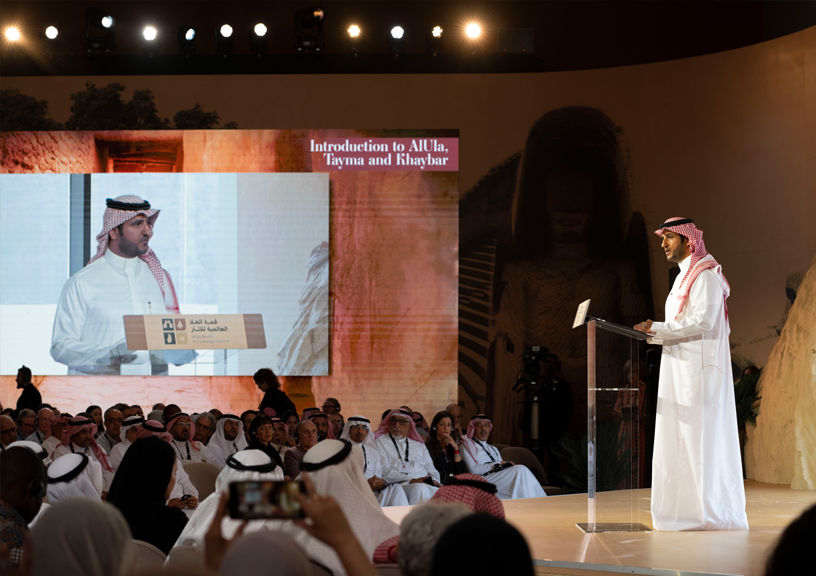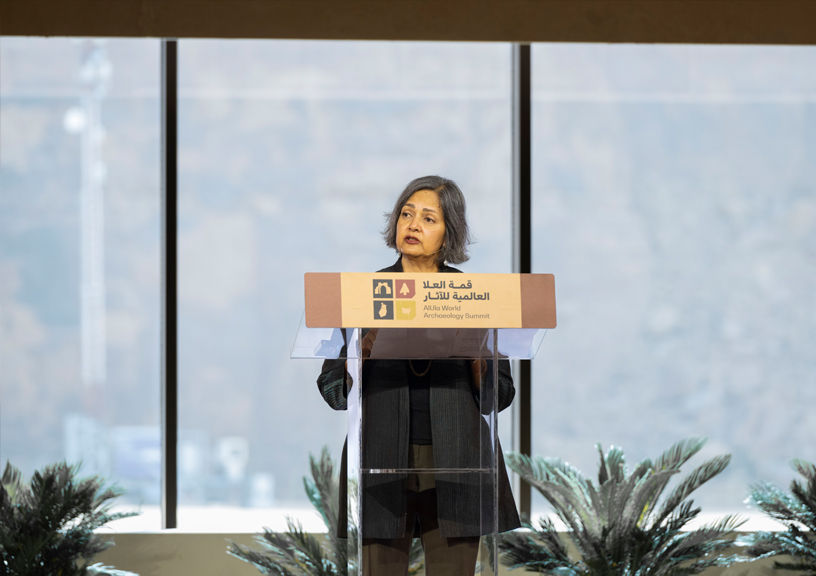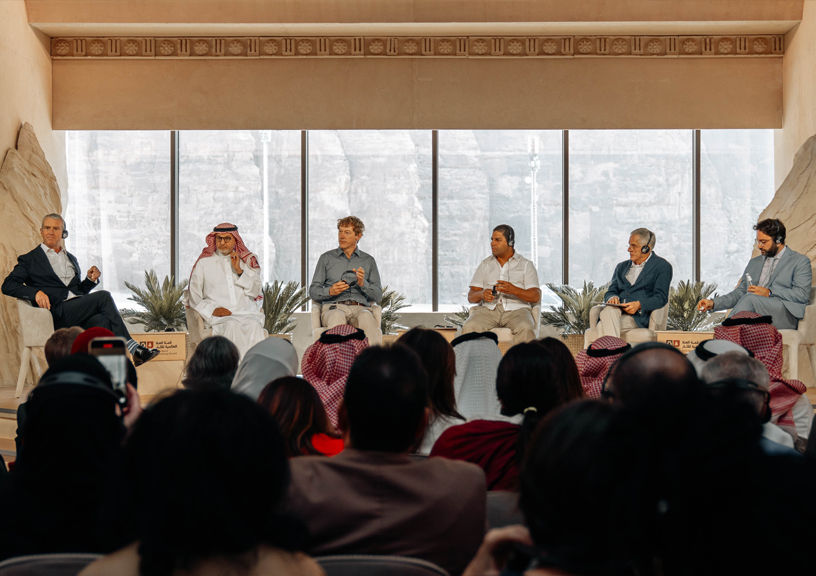From a world-class inaugural summit curation to several monumental art initiatives lined-up, AlUla’s visionary approach to archaeology and cultural heritage is nothing short of inspiring. In this exclusive conversation Dr. Abdulrahman Alsuhaibani, unveils the essence of AlUla’s rich history and its dynamic artistic future.

In the heart of Saudi Arabia lies AlUla, a cradle of archaeological wonders and cultural richness. Carved petroglyphs intricately narrate the tales of ancient civilizations, while the UNESCO-designated Hegra showcases the grandeur of the Nabataeans. AlUla’s cultural legacy echoes through the remnants of ancient trade routes, intertwining the threads of history. Today, against the backdrop of vibrant art installations like Wadi AlFann, the city not only preserves its rich past but also envisions a lively and dynamic future. Dr. Abdulrahman Alsuhaibani, the esteemed Executive Director of Archaeology, Conservation, and Collections at the Royal Commission for AlUla (RCU), unveils the insights gained from the recent AlUla World Archaeology Summit (AWAS). With 300 attendees, including 80+ speakers and 200+ global delegates, including 50 youth leaders, the summit emerged as a prestigious platform, marking a transformative moment at the crossroads of archaeology, cultural heritage, and societal evolution.

Excerpts from the interview…
Q: The AlUla World Archaeology Summit marked its maiden edition. What inspired the conception of a summit of this nature?
Dr. Alsuhaibani: The idea was to create a platform for advancing the field of archaeology, cultural heritage management, and other disciplines. This new gathering of leaders from academia, government, non-government organizations, industry, and young people representing the next generation of archaeologists was designed to not only enrich the archaeological community and help protect our shared history, but also open up to a larger reflection of what and how archaeology, and more broadly cultural heritage, can contribute to transformational changes in society. Together, we explored the value of understanding the past, of using that knowledge to inform the present, as we build a resilient future.

Q: How do you think it reinforces AlUla’s presence/importance as a place of immense architectural significance?
Dr. Alsuhaibani: The summit showcased AlUla’s position as a hub of archaeological activity. RCU is sponsoring one of the world’s largest archaeological research programs across AlUla and Khaybar, with 12 current surveys, excavations, and specialist projects. Rich cultural landscapes are being revealed, including funerary avenues, mustatils, ancient cities, inscriptions in 10 languages, rock art, and complex agricultural practices. AlUla is the site of Hegra, which in 2008 was inscribed as Saudi Arabia’s first UNESCO World Heritage Site.
Q: What were the overarching themes of the maiden edition of the summit?
Dr. Alsuhaibani: The four themes were identity, resilience, ruinscapes, and accessibility.
Q: How globally inclusive was the summit, and who were some notable participants?
Dr. Alsuhaibani: We had attendees from 39 countries. The summit’s 80+ speakers included Jyoti Hosagrahar, Deputy Director, World Heritage Center, UNESCO, with the keynote address on the summit’s first day; Prof. Shadreck Chirikure, Edward Hall Professor of Archaeological Science & Director, Research Laboratory for Archaeology and the History of Art, University of Oxford; Prof Toshiyuki Kono, Emeritus Professor of Private International Law, Kyushu University & Honorary President, ICOMOS; And as part of the youth presentation that was our closing segment, Pratibha Sharma, Punjab University, Chandigarh.

Q: How do you think conversations in archaeology and cultural heritage can contribute to wider transformational changes in society?
Dr. Alsuhaibani: Archaeology can be a vector for solving the challenges of communities across the world and affect transformational changes. The summit enabled a broad conversation and an open dialogue across disciplines about the impact of archaeology on humans and society. This cross-fertilization value for archaeology of insights from other disciplines focused on not just what is practiced, but what can happen next – exploring new frontiers, and setting the frame for future changes in the sector. The program for the summit was crafted by an Advisory Board that combined know-how from different sectors, fields of expertise, and cultures to make the summit a truly global amalgam of knowledge.
Q: How does it align with Vision 2030?
Dr. Alsuhaibani: The summit reflected RCU’s commitment to meeting the heritage preservation, economic diversification, and local community empowerment priorities of Vision 2030.
Q: Tell us about the Future Forum.
Dr. Alsuhaibani: The Future Forum provided a platform for the summit’s 50+ youth delegates to engage in meaningful dialogue and debate about the future of archaeology. It offered a space for them to develop their own perspectives and ideas and contribute to the conversation in fundamental ways.
Q: Reflecting on the first edition, what were your key learnings and observations?
Dr. Alsuhaibani: As I said to the delegates in a speech on the final day of the summit, ‘This summit was exceptional. It was unique. We discussed topics vital to the future of archaeology with a broader perspective – and I hope we continue the discussion.’ The learning has just begun.
Q: AlUla has an extremely dynamic art scene, from Wadi AlFann to Desert X AlUla. Tell us about the public art initiatives planned.
Dr. Alsuhaibani: We want our communities and all who encounter AlUla – in its landscapes, or through its activities – to share in the transformative power of the arts through the prism of AlUla’s legacies, character, and ambition. With Wadi AlFann, RCU is investing in monumental public art which highlights the region’s remarkable landscapes. Wadi AlFann will be the world’s largest display of site-specific, permanent land art. It will reshape contemporary art history by commissioning era-defining artworks from critically acclaimed artists beyond traditionally recognized art centres. Other significant public art undertakings at AlUla include: The Incense Road museum, which is among 15 new cultural assets we are creating; Perspectives Galleries for contemporary art, being developed in collaboration with the Pompidou; The Cultural Oasis, which is reviving cultural heritage with an emphasis on agriculture; Madrasat AdDeera, our academy for arts and crafts, ensures that the AlUla community is included in this artistic transformation; and global events such as Desert X AlUla and the What Lies Within exhibition.
Q: What lies ahead for the AlUla World Archaeology Summit?
Dr. Alsuhaibani: To keep the conversation going. We are looking forward to the next summit, at which we will present the inaugural AlUla World Archaeology Summit Award of Excellence promoting the science of archaeology.
